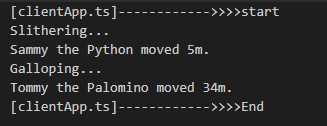标签:let his tom 错误 highlight 不同 包含 规则 OLE
这个例子展示了一些上面没有提到的特性。 这一次,我们使用extends关键字创建了Animal的两个子类:Horse和Snake。
与前一个例子的不同点是,派生类包含了一个构造函数,它必须调用super(),它会执行基类的构造函数。 而且,在构造函数里访问this的属性之前,我们一定要调用super()。 这个是TypeScript强制执行的一条重要规则。
class Animal { name: string; constructor(theName: string) { this.name = theName; } move(distanceInMeters: number = 0) { console.log(`${this.name} moved ${distanceInMeters}m.`); } } class Snake extends Animal { constructor(name: string) { super(name); } move(distanceInMeters = 5) { console.log("Slithering..."); super.move(distanceInMeters); } } class Horse extends Animal { constructor(name: string) { super(name); } move(distanceInMeters = 45) { console.log("Galloping..."); super.move(distanceInMeters); } } let sam = new Snake("Sammy the Python"); let tom: Animal = new Horse("Tommy the Palomino"); sam.move(); tom.move(34);

你可以使用readonly关键字将属性设置为只读的。 只读属性必须在声明时或构造函数里被初始化。
class Octopus { readonly name: string; readonly numberOfLegs: number = 8; constructor (theName: string) { this.name = theName; } } let dad = new Octopus("Man with the 8 strong legs"); dad.name = "Man with the 3-piece suit"; // 错误! name 是只读的.
标签:let his tom 错误 highlight 不同 包含 规则 OLE
原文地址:https://www.cnblogs.com/music-liang/p/12719461.html